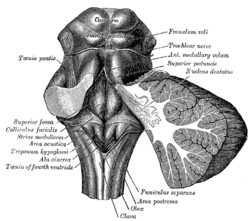
Back موضع أزرق Arabic Locus Coeruleus AST Locus ceruli Catalan Locus caeruleus German Locus cerúleo Spanish لوکوس سیرولئوس Persian Sinertävä aivotäplä Finnish Locus cœruleus French Locus ceruleus Italian 青斑核 Japanese
| Locus coeruleus | |
|---|---|
 Rhomboid fossa. (Locus coeruleus not labeled, but is very near [just lateral to] the colliculus facialis, which is labeled at center left.) | |
 Micrograph showing the locus coeruleus. HE-LFB stain. | |
| Details | |
| Identifiers | |
| Latin | locus caeruleus ("blue place") |
| MeSH | D008125 |
| NeuroNames | 583 |
| NeuroLex ID | birnlex_905 |
| TA98 | A14.1.05.436 A14.1.05.706 |
| TA2 | 5944 |
| FMA | 72478 |
| Anatomical terms of neuroanatomy | |

The locus coeruleus (/sɪˈruːliəs/) (LC), also spelled locus caeruleus or locus ceruleus,[1] is a nucleus in the pons of the brainstem involved with physiological responses to stress and panic.[2] It is a part of the reticular activating system.
The locus coeruleus, which in Latin means "blue spot", is the principal site for brain synthesis of norepinephrine (noradrenaline). The locus coeruleus and the areas of the body affected by the norepinephrine it produces are described collectively as the locus coeruleus-noradrenergic system or LC-NA system.[3] Norepinephrine may also be released directly into the blood from the adrenal medulla.
- ^ "locus coeruleus | a bluish area of the brain stem with many norepinephrine-containing neurons". www.merriam-webster.com. Retrieved 26 July 2015.
- ^ Morris LS, McCall JG, Charney DS, Murrough JW (21 July 2020). "The role of the locus coeruleus in the generation of pathological anxiety". Brain Neurosci. Adv. 4 (4:2398212820930321). doi:10.1177/2398212820930321. PMC 7479871. PMID 32954002.
- ^ Mehler, Mark F.; Dominick P. Purpura (March 2009). "Autism, fever, epigenetics and the locus coeruleus". Brain Research Reviews. 59 (2): 388–392. doi:10.1016/j.brainresrev.2008.11.001. PMC 2668953. PMID 19059284.
© MMXXIII Rich X Search. We shall prevail. All rights reserved. Rich X Search